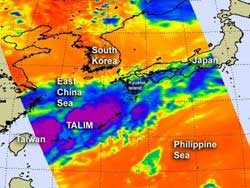NASA sees Tropical Depression Talim becoming disorganized

NASA's AIRS instrument (on the Aqua satellite) captured this infrared image of Tropical Depression Talim on June 21 at 3:29 a.m. EDT. The remaining scattered strongest thunderstorms have high, cold cloud tops of -63F (-52C). Credit: NASA/JPL, Ed Olsen<br>
NASA's Aqua satellite Atmospheric Infrared Sounder (AIRS) instrument captured an infrared image of Tropical Depression Talim on June 21 at 3:29 a.m. EDT. The imagery showed several areas of strong thunderstorms, but they're now scattered in nature as a result of the two factors.
As Talim moved over Taiwan and interacted with the land it weakened. Another factor that added to its rapid weakening was an increase in vertical wind shear (winds that batter a storm)from a nearby frontal system. The AIRS data did reveal that some of those scattered thunderstorms were still strong and had high, cold cloud tops of -63 Fahrenheit or -52 Celsius. Those thunderstorms were still dropping heavy rainfall and were occurring mostly over open water at the time of the AIRS image.
On June 21, 2012 at 0000 UTC (June 20 at 8 p.m. EDT/U.S.), Talim's maximum sustained winds were down to 25 knots (28.7 mph/46.3 kph). At that time, Talim was 100 nautical miles (115 miles/185 km) northeast of Taipei, Taiwan and moving east-northeast at 15 knots (17.2 mph/27.7 kph).
Forecasters at the Joint Typhoon Warning Center expect the depression to dissipate later today as it interacts with a frontal boundary that stretches from the Sea of Japan to the South China Sea. That system is expected to brush Kyushu Island, Japan.
Media Contact
More Information:
http://www.nasa.govAll latest news from the category: Earth Sciences
Earth Sciences (also referred to as Geosciences), which deals with basic issues surrounding our planet, plays a vital role in the area of energy and raw materials supply.
Earth Sciences comprises subjects such as geology, geography, geological informatics, paleontology, mineralogy, petrography, crystallography, geophysics, geodesy, glaciology, cartography, photogrammetry, meteorology and seismology, early-warning systems, earthquake research and polar research.
Newest articles

High-energy-density aqueous battery based on halogen multi-electron transfer
Traditional non-aqueous lithium-ion batteries have a high energy density, but their safety is compromised due to the flammable organic electrolytes they utilize. Aqueous batteries use water as the solvent for…

First-ever combined heart pump and pig kidney transplant
…gives new hope to patient with terminal illness. Surgeons at NYU Langone Health performed the first-ever combined mechanical heart pump and gene-edited pig kidney transplant surgery in a 54-year-old woman…

Biophysics: Testing how well biomarkers work
LMU researchers have developed a method to determine how reliably target proteins can be labeled using super-resolution fluorescence microscopy. Modern microscopy techniques make it possible to examine the inner workings…





















